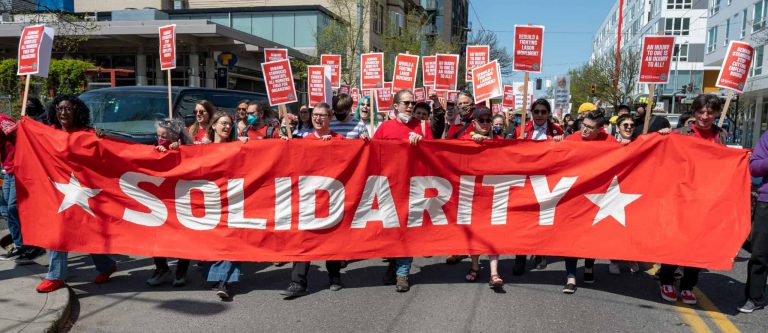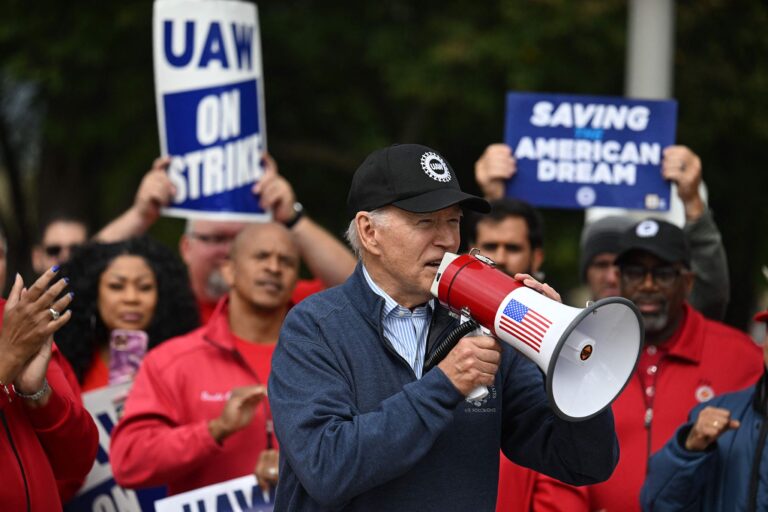
Julia Huang is a student at Harvard Law School and a member of the Labor and Employment Lab.
On January 29, 2022, postproduction staff at Vice Media ratified a new three-year agreement with the company by a 97% margin. These staff members are a part of Local 700, the Editors Guild of the International Alliance of Theatrical Stage Employees (IATSE). The union members secured 40-hour workweeks, down from 50 hours, and high pay increases, up to 48.4% higher for the lowest-paid members. Were these Vice Media staffers inspired by last year’s IATSE movement in Hollywood?
From October 1 to October 3, 2021, IATSE union members associated with Hollywood producers, studios, and streamers voted to authorize a strike. Of the 89.7% of members who participated, 98.7% voted yes. Without proper contingency plans in place, movie- and TV-production sets across the country would have shut down. But just as the strike was set to start, a tentative agreement with the Alliance of Motion Picture and Television Producers (AMPTP) was reached on October 16, 2021. On November 15, 2021, IATSE members ratified the agreement.
Who Was Involved?
IATSE is a labor union that represents over 150,000 workers in the entertainment industry, including technicians, set builders, makeup artists, and camera operators. The contracts that were in dispute—the Producer-IATSE Basic Agreement and the Theatrical and Television Motion Picture Area Standards Agreement—cover about 63,000 members. The Basic Agreement covers the 13 unions surrounding Hollywood, while the Area Standards Agreement covers 23 local unions in other areas of the U.S.
AMPTP engages in negotiations with almost all industry-wide guild and union contracts as the bargaining entity for most major studios, including Netflix, Amazon, Walt Disney Studios, Apple, and Warner Bros.
Ratification Results
Through an electoral college system, the affected IATSE locals were assigned a number of delegates based on their membership size. All delegates for a local union were assigned to a “ratify” or “reject” result according to the local union’s majority vote. Popular votes were also tabulated. 72% of eligible IATSE members casted votes:
| Yes | No | |
| Total Delegate Vote | 56% | 44% |
| Total Popular Vote | 50.3% | 49.7% |
| Basic Agreement Delegate Vote | 70% | 30% |
| Basic Agreement Popular Vote | 49.6% | 50.4% |
| Area Standards Agreement Delegate Vote | 52% | 48% |
| Area Standards Agreement Popular Vote | 52% | 48% |
What Was at Stake?
When it had first announced the strike authorization, IATSE called on AMPTP to improve the following conditions:
- Excessively unsafe and harmful working hours;
- Unlivable wages for the lowest paid crafts;
- Consistent failure to provide reasonable rest during meal breaks, between workdays, and on weekends;
- Workers on certain “new media” streaming projects getting paid less, even on productions with budgets that rival or exceed those of traditionally released blockbusters.
What Prompted These Demands?
In order to meet the increased demand for content after the pandemic shut down productions, returning workers quickly faced long workdays with few or no breaks. Budgeting in these costs from the start, productions regularly chose to pay contractual penalties instead of stopping production for mandated rest periods and lunch breaks.
While workers earned higher overtime pay as a result, the lack of downtime has adversely affected their health and safety. Hours before the fatal shooting of cinematographer Halyna Hutchins, the camera crew for the movie Rust had walked off set in protest over unsafe workplace conditions, 12–13 hour-long workdays, and hour-long commutes.
These poor conditions are the norm. IATSE members occupy what has commonly been referred to as “below-the-line” jobs, which are paid at a variable rate. Before the new contracts, an example of a local union’s minimum hourly rate for an art department coordinator had been $16.52, just barely over California’s minimum wage. 59% of support staffers reported that they were unable to negotiate away from that minimum. Work in the industry is sporadic and workers are not paid when shooting is delayed or canceled. If they are not consistently staffed, a 40-hour workweek is not guaranteed and even overtime wages can fall short. In its 128-year history, IATSE has never held a strike, likely because many members are living month-to-month off their wages. Previous contract negotiations have also increased the number of hours a union member must work to qualify for health and pension coverage.
Streaming platforms worsen this imbalance between wages and hours worked. During contract negotiations in 2009, streamed content was still considered “new media,” and the union agreed to give online distribution services worker subsidies until new media production “became an economically viable medium.” Despite proven profits, streaming services with fewer than 20 million subscribers did not have to pay a specific scale wage or credit pension hours. Instead of paying the level of pay expected for network series, they paid lower TV movie levels.
Larger streaming platforms still cheat union members out of fair wages because of the current system for residual payments. For below-the-line workers, residuals from producers fund their pension and healthcare funds. Whenever a show is rerun in a secondary market or transferred to a new format (i.e., DVDs), crew members profit. However, streaming services like Netflix, Amazon, and Hulu are not selling their content to other markets; despite being billion-dollar companies, they make only a one-time payment towards workers’ funds.
Does the Ratified Agreement Meet Members’ Demands?
IATSE leadership celebrated the “adequate rest” and “stiff financial penalties” of the new agreement. Specifically, new rest requirements include 10-hour daily turnarounds, 54-hour weekend rest periods for 5-day weeks, and 32-hour weekends for 6-day weeks. However, critics argue that 10-hour rest periods are already mandated by many workers’ contracts and may indirectly sanction 14-hour workdays. The new break penalties also impose nothing new for productions going past six hours without a break. Instead, they double penalties from $12.50/half hour to $25/half hour after eight hours. After 20 meal penalties, a worker will earn their hourly wage for each additional half-hour penalty.
In terms of wages, the lowest-paid positions will have their minimum wage raised to $26/hour by the third year. A significant focus of the negotiations, the wage increase equates to a 62% raise for these IATSE members. Overall, there will be a 3% annual raise. Dissatisfied IATSE members argue that the lowest paid workers had wanted at least $30/hour and that the 3% annual raise is a normal contractual term that barely meets inflation. While workers’ pension and health funds will be given an additional $370 million over three years, streaming services still do not have to contribute residuals. Instead, streaming services will have to pay more in wages depending on the type of series being produced.
The ratified agreement also outlines a program to promote “off-roster” hiring of workers from disadvantaged communities. Will this improve diversity when minorities have been disproportionately excluded from IATSE membership?
After calling the agreement reached a “Hollywood ending,” IATSE’s international president, Matthew Loeb, praised the ratification results for “[meeting] our objectives for this round of bargaining,” and for “[driving] more participation in our union long-term.” Compared to the last contract vote, turnout this year almost doubled. Critics agree; union participation will increase. Local 600 members already promise to “organize and fight for the next contract cycle” in three years’ time. Perhaps in 2024, IATSE members in Hollywood will win even more. In the meantime, perhaps other IATSE members can learn from what they have gained.










Daily News & Commentary
Start your day with our roundup of the latest labor developments. See all
July 11
Regional director orders election without Board quorum; 9th Circuit pauses injunction on Executive Order; Driverless car legislation in Massachusetts
July 10
Wisconsin Supreme Court holds UW Health nurses are not covered by Wisconsin’s Labor Peace Act; a district judge denies the request to stay an injunction pending appeal; the NFLPA appeals an arbitration decision.
July 9
the Supreme Court allows Trump to proceed with mass firings; Secretary of Agriculture suggests Medicaid recipients replace deported migrant farmworkers; DHS ends TPS for Nicaragua and Honduras
July 8
In today’s news and commentary, Apple wins at the Fifth Circuit against the NLRB, Florida enacts a noncompete-friendly law, and complications with the No Tax on Tips in the Big Beautiful Bill. Apple won an appeal overturning a National Labor Relations Board (NLRB) decision that the company violated labor law by coercively questioning an employee […]
July 7
LA economy deals with fallout from ICE raids; a new appeal challenges the NCAA antitrust settlement; and the EPA places dissenting employees on leave.
July 6
Municipal workers in Philadelphia continue to strike; Zohran Mamdani collects union endorsements; UFCW grocery workers in California and Colorado reach tentative agreements.